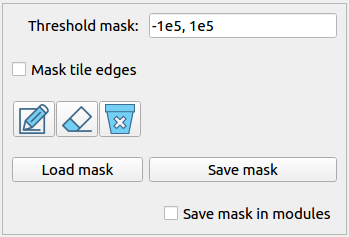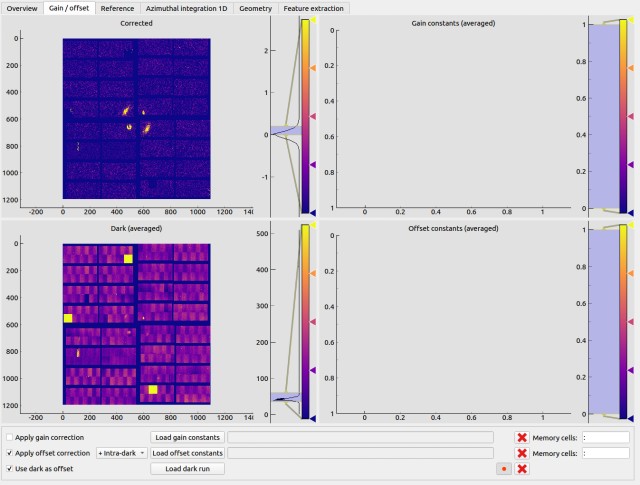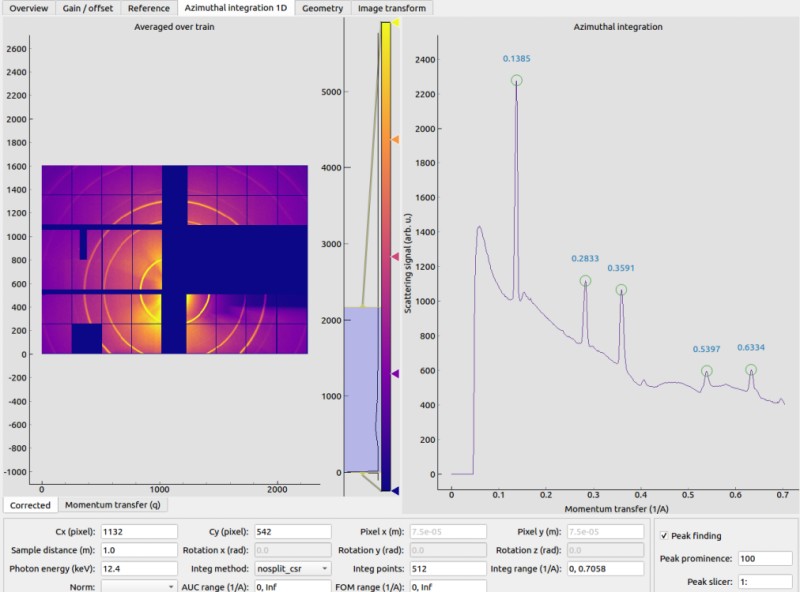Image tool¶
The ImageTool window is the second control window which provides various image-related information and controls.

Image control¶
| Input | Description |
|---|---|
Update image |
Manually update the current displayed image in the ImageTool window. Disabled if Update automatically is checked. |
Update automatically |
Automatically update the current displayed image in the ImageTool window. |
Moving average |
Apply moving average to the image data. It affects both the individual images in a train and the averaged image, as well as the subsequent analysis. If a new window size is smaller than the old one, the moving average calculation will start from the scratch. |
Auto level |
Update the detector images (not only in the ImageTool window, but also in other plot windows) by automatically selecting levels based on the maximum and minimum values in the data. |
Save image |
Save the current image to file. Please also see ImageFileFormat |
Warning
The moving average here is not calculated by nanmean, which means that if a pixel of the image in a certain pulse is NaN, the moving average of that pixel will be NaN for that pulse.
Warning
Please be aware that there is another moving average setup in the Global setup in the main GUI.
Mask panel¶

Besides the nan pixels inherited from the calibration pipeline, users are allowed to mask additional pixels to nan in this panel with threshold mask, tile edge mask and image mask.
It should be noted that image mask is treated differently in EXtra-foam. One can draw and erase image mask at run time as well as save/load it as an assembled image or in modules if the detector has a geometry. Nan pixels outside the masked region of the image mask will not be saved and thus will also not be overwritten after loading an image mask from file.
| Input | Description |
|---|---|
Threshold mask |
An interval that pixels with values outside the interval will be masked. Please distinguish threshold mask from clipping. |
Mask tile edges |
Mask the edge pixel of each tile. Only applicable for AGIPD, LPD
and DSSC if EXtra-foam is selected as the Assembler in
Geometry. |
Mask ASIC edges |
Mask the edge pixel of each ASIC. Only applicable for JungFrau and ePix100. |
Draw |
Draw mask in a rectangular region. Only available in the Corrected panel. |
Erase |
Erase mask in a rectangular region. Only available in the Corrected panel. |
Remove mask |
Remove the image mask. |
Load mask |
Load an image mask in .npy format. The dtype of the loaded numpy array will be casted into bool if it is not. For detectors with a geometry, it is allowed to load an image mask in modules, i.e., an array which has the shape (modules, ss, fs). |
Save mask |
Save the current image mask in .npy format. |
Save mask in modules |
Save image mask in modules. Only applicable for AGIPD, LPD
and DSSC if EXtra-foam is selected as the Assembler in
Geometry. |
ROI manipulation¶
You can activate (tick On) up to 4 ROIs at the same time. One can change the size (width, height) and position (x, y) of an ROI by either dragging and moving the ROI on the image or entering numbers. You can avoid modifying an ROI unwittingly by Locking it.
ROI FOM setup¶
| Input | Description |
|---|---|
Combo |
ROI combination, including ROI1, ROI2, ROI1 + ROI2, ROI1 - ROI2, and ROI1 / ROI2. |
FOM |
ROI FOM type, including SUM, MEAN, MEDIAN, MIN, MAX. STD, VAR, STD (norm) and VAR (norm). |
Norm |
Normalizer of ROI FOM. Only applicable for train-resolved and pump-probe analysis. |
Master-slave |
Check to activate the master-slave model. This model is used exclusively in Correlation window. When it is activated, FOMs of ROI1 (master) and ROI2 (slave) will be plotted in the same correlation plot. For other statistics analysis like binning and histogram, only ROI1 FOM will be used. |
- STD (norm) is defined as the ratio between the standard deviation and the mean.
- VAR (norm) is defined as the ratio between the variance and the square of the mean.
ROI histogram setup¶
| Input | Description |
|---|---|
Combo |
ROI combination, e.g. ROI1, ROI2, ROI1 + ROI2, ROI1 - ROI2. |
Bin range |
Lower and upper boundaries of all the bins. In case of +/- Inf, the boundary will be calculated dynamically. |
# of bins |
Number of bins of the histogram. |
ROI normalizer setup¶
The settings for this are on the ROI normalizer settings tab. The normalization source can either be the main detector, or some other 2D source image. To use a different source, such as a camera, add it as a pipeline source (purple square) in the Data source tree under the User-defined section, and if it is a 2D image it will be displayed as an option in the ROI source list.
| Input | Description |
|---|---|
ROI source |
Source to compute the normalization factor from. |
Combo |
ROI combination, e.g. ROI3, ROI4, ROI3 + ROI4, ROI3 - ROI4. |
FOM |
ROI FOM type, e.g. SUM, MEAN, MEDIAN, MIN, MAX. |
ROI projection setup¶
Define the 1D projection of ROI (region of interest) analysis setup.
| Input | Description |
|---|---|
Combo |
ROI combination, e.g. ROI1, ROI2, ROI1 + ROI2, ROI1 - ROI2. |
Direction |
Direction of 1D projection (x or y). |
Norm |
Normalizer of the 1D-projection VFOM. Only applicable for train-resolved and pump-probe analysis. |
AUC range |
AUC (area under a curve) integration range. |
FOM range |
Integration range when calculating the figure-of-merit of 1D projection. |
Photon binning setup¶
This bins the data from the detector based on an ADU threshold, which corresponds to the raw value recorded by a detector for one photon. The binning uses the formula:
| Input | Description |
|---|---|
ADU threshold |
The ADU threshold to use for binning. A reasonable value for this could be found from the histogram of the image by looking for a visible ‘step’ between the counts of one and two photons. |
Gain / offset¶

Apply pixel-wised gain and offset correction, where
Users can record a “dark run” whenever data is available. The dark run consists of a number of trains. The moving average of the each “dark pulse” in the train will be calculated, which will then be used to apply dark subtraction to image data pulse-by-pulse.
| Input | Description |
|---|---|
Apply gain correction |
Check to activate gain correction. |
Apply offset correction |
Check to activate offset correction. Since version 1.10, a variation of offset correction has been introduced:
|
Use dark as offset |
Check to use recorded dark images as offset. The already loaded offset constants will be ignored. |
Record dark |
Start and stop dark run recording. |
Remove dark |
Remove the recorded dark run. |
Warning
The moving average here is not calculated by nanmean, which means that if a pixel of the image in a certain pulse is NaN, the moving average of that pixel will be NaN for that pulse.
Note
Some detectors have its own special treatment for gain/offset correction:
DSSC:
Due to the readout issue, pixels with value 0 will be converted to 256.
Reference image¶
| Input | Description |
|---|---|
Load reference |
Load a reference image from file. Please also see ImageFileFormat |
Set current as reference |
Set the current displayed image as a reference image. For now, reference image is used as a stationary off-image in the predefined off mode in pump-probe analysis. |
Record reference |
Record the received displayed images and perform a moving average
until the Stop (recording) button has been toggled.
The resulting image will be set as a reference image. |
Save reference |
Saves the reference image to a NumPy file. |
Remove reference |
Remove the reference image. |
Note
Image file format
The two recommended image file formats are .npy and .tif. However, depending on the OS, the opened file dialog may allow you to enter any filename. Therefore, in principle, users can save and load any other image file formats supported by imageio. However, it can be wrong if one writes and then loads a .png file due to the auto scaling of pixel values.
Azimuthal integration 1D¶
EXtra-foam uses pyFAI to do azimuthal integration. As illustrated in the sketch below, the origin is located at the sample position, more precisely, where the X-ray beam crosses the main axis of the diffractometer. The detector is treated as a rigid body, and its position in space is described by six parameters: 3 translations and 3 rotations. The orthogonal projection of origin on the detector surface is called PONI (Point Of Normal Incidence). For non-planar detectors, PONI is defined in the plan with z=0 in the detector’s coordinate system. It is worth noting that usually PONI is not the beam center on the detector surface.
The input parameters Cx and Cy correspond to Poni2 and Poni1 in the aforementioned coordinate system, respectively.


| Input | Description |
|---|---|
Cx (pixel) |
Coordinate of the point of normal incidence along the detector’s 2nd dimension. |
Cy (pixel) |
Coordinate of the point of normal incidence along the detector’s 1st dimension. |
Pixel x (m) |
Pixel size along the detector’s 2nd dimension. |
Pixel y (m) |
Pixel size along the detector’s 1st dimension. |
Sample distance |
Sample-detector distance in m. Only used in azimuthal integration. |
Rotation x (rad) |
Not used |
Rotation y (rad) |
Not used |
Rotation z (rad) |
Not used |
Photon energy (keV) |
Photon energy in keV. Only used in azimuthal integration for now. |
Integ method |
Azimuthal integration methods provided by pyFAI. |
Integ points |
Number of points in the output pattern of azimuthal integration. |
Integ range (1/A) |
Azimuthal integration range. |
Norm |
Normalizer of the scattering curve. Only applicable for train-resolved and pump-probe analysis. |
AUC range (1/A) |
AUC (area under curve) range. |
FOM range (1/A) |
Integration range when calculating the figure-of-merit of the azimuthal integration result. |
By default, peak finding is activated and peak positions will be annotated along the scattering curve if the number of detected peaks is between 1 and 10. There is no special reason for choosing 10 as the upper limit. Nevertheless, if there are two many peaks found, it may be due to a noisy scattering curve or some unreasonable peak-finding parameters.
For now, users can set prominence to refine the number of detected peaks and use a slicer to select part of them. The prominence of a peak measures how much a peak stands out from the surrounding baseline of the signal and is defined as the vertical distance between the peak and its lowest contour line. The slicer is useful when the scattering curve has some undesired structure, especially at the start and/or end of the curve.
| Input | Description |
|---|---|
Peak finding |
Check to activate real-time peak finding and annotating. |
Peak prominence |
Minimum prominence of peaks. |
Peak slicer |
Pixel size along the detector’s 2nd dimension. |
EXtra-foam also has its own fast azimuthal integration implemented in C++. On a cluster with 40 cores, it takes about only 9 ms to integrate a train of 40 1.3-Megapixel images. Unfortunately, this implementation has not been integrated into the GUI for now.

Geometry¶
Geometry is only available for the detector which requires a geometry to assemble the images from different modules, for example, AGIPD, LPD, DSSC as well as JungFrau and ePix100 used in a combined way.
For details about geometries of AGIPD, LPD and DSSC, please refer to this documentation. It should be noted that the online and offline data format are different. For real-time data received from the ZMQ bridge, all the 16 modules have been stacked in a single array and the source name is usually a Karabo device name. However, for data streamed from files, modules data are distributed in different files and each module has a unique source name. For example, DSSC modules at SCS are named as SCS_DET_DSSC1M-1/DET/0CH0:xtdf, SCS_DET_DSSC1M-1/DET/1CH0:xtdf, …, SCS_DET_DSSC1M-1/DET/15CH0:xtdf. EXtra-foam relies on the “index” (0 - 15) in the source name to find the corresponding module. Accordingly, in the Data source tree, one should use SCS_DET_DSSC1M-1/DET/*CH0:xtdf as the source name, which has a ‘*’ at the location where the module index is expected.
LPD-1M with 16 modules:

EXtra-foam implemented a generalized geometry for detectors like JungFrau and ePix100. To allow more than one modules, one must explicitly specify the number of modules in the command line at startup. Similar to AGIPD, LPD and DSSC, the online and offline data format can be different. For real-time data received from the ZMQ bridge, all the modules could have been stacked in a single array and the source name is usually a Karabo device name. However, it also supports data arriving in modules, as data streamed from files. Similarly, it relies on the “index” in the source name to find the corresponding module. Different from AGIPD, LPD and DSSC, the module index starts from 1. For example, JungFrau modules at SPB are named as SPB_IRDA_JNGFR/DET/MODULE_1:daqOutput, SPB_IRDA_JNGFR/DET/MODULE_2:daqOutput, …, SPB_IRDA_JNGFR/DET/MODULE_8:daqOutput. Similarly, in the Data source tree, one should use SPB_IRDA_JNGFR/DET/MODULE_*:daqOutput as the source name.
6-module JungFrau with geometry file in the CFEL format. Module 1 is located on the top-right corner and all modules (1, 2, 3, 6, 7, 8) are arranged in closewise order.

2-module ePix100 without geometry file. Module 1 is located on top of module 2.

| Input | Description |
|---|---|
Quadrant positions |
The first pixel of the first module in each quadrant, corresponding to data channels 0, 4, 8 and 12. Only avaible for 1M detectors, i.e. AGIPD, LPD and DSSC, with non-CFEL format geometry file. |
Module positions |
The first pixel of each module. Only available for JungFrau and ePix100 with non-CFEL format geometry file. Not implemented yet |
Load geometry file |
Open a FileDialog window to choose a geometry file from the
local file system. Ignored if Stack without geometry file
is checked. |
Assembler |
There are two assemblers available in EXtra-foam for AGIPD, LPD and DSSC. One is EXtra-geom implemented in Python and the other is the local C++ implementation. Indeed, the latter follows the assembling methodology implemented in the former but is much faster with multi-core processors. |
Stack without geometry file |
When the checkbox is checked, the modules will be seamlessly stacked together. Unfortunately, it does not mean that this will be faster than assembling with a geometry. It simply provides an alternative to check the data from different modules. |
Feature Extraction¶
Here, one can visualize the original image and its transform side by side. The transformed image can be further used for feature extraction. A feature extraction analysis will be activated only if the corresponding control widget tab is activated. Not all transformed images support feature extraction and not all feature extractions require a prior image transform.
| Input | Description |
|---|---|
Moving average window |
Use moving averaged image to suppress background noise and enhance features. |
Concentric rings¶

Find the center of concentric rings in an image. It is typically used in finding the center for Azimuthal integration 1D. It is only available when the data processing pipeline is not running, i.e., it cannot be used in real-time analysis.
| Input | Description |
|---|---|
Cx |
Initial guess for the x coordinate of the center, in pixel. |
Cy |
Initial guess for the y coordinate of the center, in pixel. |
Prominence |
Prominence of the ring. |
distance |
Minimum horizontal distance between neighbouring rings. |
Min. count |
Minimum number of valid pixels required for the ring. The nan pixels are excluded. |
Detect |
Click to find the optimized center. If found, the number in Cx
and Cy will be updated and the detected rings will be marked
in the transformed image. |
Fourier transform¶

Apply 2D discrete Fourier Transform to the original image and shift the zero-frequency component to the center of the spectrum using fft package in scipy.
| Input | Description |
|---|---|
Logrithmic scale |
Check to display the amplitude in logrithmic scale. |
Edge detection¶
Detect edges in the original image and the transformed image is a binary image which shows the edge and non-edge pixels. EXtra-foam uses a similar algorithm to Canny edge detection to detect edges.
| Input | Description |
|---|---|
Kernel size |
kernel size for Gaussian blur. |
Sigma |
Gaussian kernel standard deviation. |
Threshold |
(first, second) thresholds for the hysteresis procedure. |